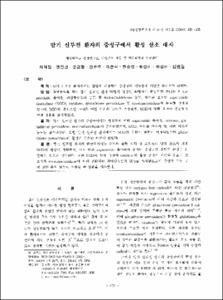말기 신부전 환자의 중성구에서 활성 산소 대사
- Alternative Author(s)
- Mun, Kyo Cheol; Kwak, Chun Sik; Han, Seung Yeup; Hwang, Eun Ah; Park, Sung Bae; Kim, Hyun Chul
- Journal Title
- 대한신장학회지
- ISSN
- 1225-0015
- Issued Date
- 2004
- Abstract
- Background : The present study was aimed to know the cause of impaired bactericidal activity, especially the metabolism of oxygen free radicals in neutrophils from patients with end-stage renal disease (ESRD).
Methods : We measured the amount of superoxide anion, the activity of three antioxidant enzymes, myeloperoxidase, copper ion level, zinc ion level and the amount of malondialdehyde in neutrophils from patients with ESRD before and after hemodialysis. Reverse transcription-polymerase chain reaction (RT-PCR) for superoxide dismutase (SOD) was also done.
Results: The malondialdehyde level, the amount of superoxide anion, catalase, and myeloperoxidase levels in the neutrophils from the patients with ESRD were higher than those from healthy controls. SOD activity, hydrogen peroxide level and zinc level were lower in ESRD patients. On the RT-PCR, the relative index, which is defined the ratio of the band densities for SOD to glyceraldehyde 3-phosphate dehydrogenase, was decreased in neutrophils from patients with ESRD. Glutathione peroxidase activity in the neutrophils from ESRD patients did not show any significant change.
Conclusion : These results indicate that there are some alterations in metabolism of oxygen free radicals including lower levels of hydrogen peroxide which exerting a direct germicidal ability, due to decreased gene expression and mineral levels. And these alterations might be one of the major mechanisms of impaired microbicidal activity in patients with ESRD.
목 적 : 말기 신부전 환자에서는 감염에 대항하는 중성구의 기능장애 기전을 밝히고자 하였다.
방 법 : 혈액투석을 하는 말기 신부전 환자 50명과 정상인 40명에서 중성구를 분리한 후 su-peroxide 음이온, 과산화수소의 농도 및 malondiaWehyde 농도,항산화 효소인 superoxide dismutase (SOD), catalase, glutathione peroxidase 및 myeloperoxidase의 농도를 측정하 였으며, SOD의 조효소인 구리와 아연 이온의 농도를 측정하고, SOD에 대한 역전사 중합효소 연쇄 반응을 실시하였다.
결 과: 말기 신부전 환자의 중성구에서는 정상인에 비해 superoxide 음이온, catalase, glutathione peroxidase, malondialdehyde가 증가하였으며, SOD, 과산화 수소의 양, 아연 이온의 농도는 감소하였다. 또한 말기 신부전 환자에서는 SOD의 유전자 발현이 억제되었으며 gluta-thione peroxidase의 활성은 유의한 변동이 없었다.
결 론 : 말기 신부전 환자의 중성구에서는 유전자 발현 억제 및 조효소의 양적 감소에 의해 SOD의 활성이 저하되며, 이로 인한 superoxide 음이온의 증가는 중성구의 산화적 손상을 유 발하는 것으로 생각된다. 또한 SOD의 활성 저하와 catalase의 활성 증가는 과산화 수소를 감 소시켜 myeloperoxidase에 의해 전환되는 차아염소산의 감소를 초래함으로서 중성구 기능 장 애 원인 중의 일부로 작용할 수 있음을 시사한다.
- Alternative Title
- Metabolism of Reactive Oxygen Species in Neutrophils from Patients with End-Stage Renal Disease
- Publisher
- School of Medicine
- Citation
- 최혜정 et al. (2004). 말기 신부전 환자의 중성구에서 활성 산소 대사. 대한신장학회지, 23(3), 429–438.
- Type
- Article
- ISSN
- 1225-0015
- 파일 목록
-
-
Download
 oak-bbb-02414.pdf
기타 데이터 / 857.51 kB / Adobe PDF
oak-bbb-02414.pdf
기타 데이터 / 857.51 kB / Adobe PDF
-
Items in Repository are protected by copyright, with all rights reserved, unless otherwise indicated.